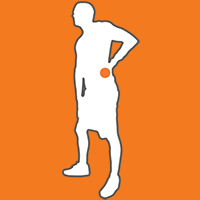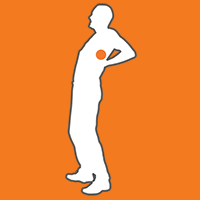At some point in their lives, most people will experience some level of back pain.1 When this happens, people are often left wondering why — in fact, statistics show that 90% of sufferers are lost when it comes to figuring out exactly where their pain came from.2 Back pain can arise from a wide variety of causes ranging from injury to daily wear and tear.
Upper Back Pain vs. Lower Back Pain
When you’re experiencing discomfort, it can be easy to generalize your symptoms as “back pain”. But there are actually differences between pain in your upper and your lower back. Understanding these differences can help to diagnose the cause and appropriate treatment for your pain.

Lower Back Pain
Lower back pain is the more common ailment, and usually occurs between ages 40-80. Children can also experience lower back pain, however, especially from carrying heavy backpacks.3 Lower back pain tends to involve the muscles of the lower back but can also involve the nerves and bones as well. The causes vary widely from injury and bodily degeneration to general overuse. Dull pain and sharp pain can both be common with lower back pain.
Sufferers can get relief through resting the back, mild stretching and exercise. Heat and ice therapy are recommended along with staying active in many cases. Muscles sometimes need to move in order to heal.

Upper Back Pain
Upper back pain is usually centered around the shoulders and neck, and can come with accompanying symptoms like burning, numbness, weakness, loss of mobility and fatigue.4 We demand a lot of our backs, and the large muscles of the back can become irritated from overuse. Upper back pain can also be the result of injury or herniated discs.
Often this pain will go away on its own after a little rest. If your upper back pain is minor, light stretching is recommended, along with working to improve your posture.5 When it comes to more severe pain, ice and heat therapy can help, along with massage therapy and acupuncture.
What Behaviours Contribute to Back Pain?
In some cases, your back pain might just be an outcome of your DNA. Recent studies have concluded that there is a genetic link between spine disease and degenerative disc disease.6 Most frequently, it is not genetics, but day-to-day activities that lead to back pain. A little focus on prevention can go a long way.
Take a Look at Your Posture
Bad posture can contribute to back pain, as slouching when sitting or standing can place additional strain on both ligaments and muscles. Correcting poor posture ensures that these structures receive the support they need to keep pain at bay.
Increase Your Level of Physical Activity
For many, today’s modern lifestyle means too much sitting and not enough exercise, which can lead to back pain.7 Exercise is a key way to increase strength in muscles and ligaments as well improve the health of soft tissue and spinal discs.
Maintain a Healthy Weight
Carrying excess weight can also contribute to pack pain. The reason is that extra weight pulls the pelvis area forward. When the pelvis is pulled forward, the back is placed under greater stress.8, 9
Eat a Nutritious Diet
When you get the right vitamins and minerals, it will support healthy bones, muscles and nerve cells, improve circulation and help in the healing process.10 Calcium and Vitamin D have also been shown to prevent osteoporosis, which is another condition linked to back pain.
Reduce Stress
If you lead a stressful lifestyle, you’ll be more susceptible to back pain. Deep breathing and relaxation will help you avoid this condition and also help you feel better in general.11
Avoid Smoking
Studies have concluded that smokers are up three times more likely to experience lower back pain.12
Everything from injury and lifestyle choices to weight gain can lead to back pain. The good news is that there are many ways to address back pain and get some relief. Understanding the symptoms and causes of back pain can ensure that the treatment approach is effective and appropriate, such as resting the back or stretching and exercise. An over-the-counter treatment such as MOTRIN® Liquid Gels or MOTRIN® Platinum Muscle & Body can also help to alleviate the pain and discomfort associated with back pain and get you back up and running in no time!
This information does not constitute a diagnosis of any medical condition or medical advice. Do not substitute this information for medical advice. Always consult your physician or health care provider if you have medical or health questions or concerns. To be sure this product is right for you, always read and follow the label.
References
1. https://www.chiropractic.ca/blog/canadas-low-back-pain-epidemic/
2.http://www.thegoodbody.com/back-pain-statistics/
3. http://www.michiganspineandpain.com/real-pain-real-solutions/diagnosis/low-back-pain/
4. http://www.backpainrelief.net/upper-back-pain/
5. http://www.webmd.com/back-pain/tc/upper-and-middle-back-pain-home-treatment
6. http://www.webmd.com/back-pain/news/20110204/back-pain-may-be-inherited
7. https://www.chiropractic.ca/blog/canadas-low-back-pain-epidemic/
8. https://www.spineuniverse.com/conditions/back-pain/back-pain-obesity
9. https://www.chiropractic.ca/blog/canadas-low-back-pain-epidemic/
10. http://www.livestrong.com/article/370888-vitamins-for-back-pain/
11. http://www.webmd.com/back-pain/tc/upper-and-middle-back-pain-home-treatment
12. https://consumer.healthday.com/encyclopedia/back-care-6/backache-news-53/back-pain-and-smoking-645336.html

